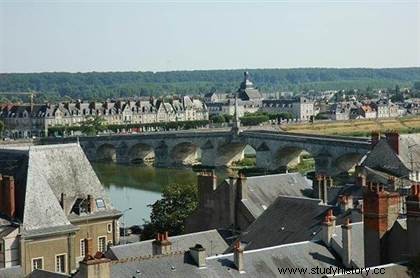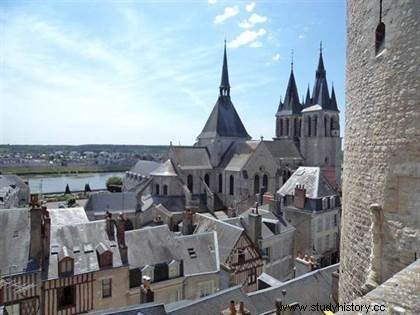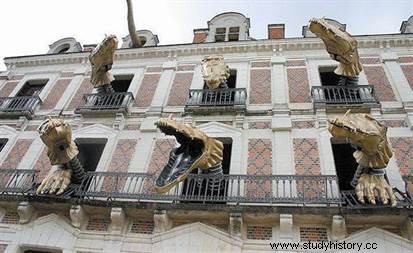 Blois . When we think of it, we think above all of its royal castle, a magnificent example of the evolution of French architecture from the Middle Ages to the 19
th
century. Nevertheless, Blois is also an old town which has seen more than 1000 years of French history pass and whose rich built heritage also reflects this evolution of French architecture. Blois thus presents a panorama of architectural styles today highlighted by its "city of art and history" label and the resulting events.
Blois . When we think of it, we think above all of its royal castle, a magnificent example of the evolution of French architecture from the Middle Ages to the 19
th
century. Nevertheless, Blois is also an old town which has seen more than 1000 years of French history pass and whose rich built heritage also reflects this evolution of French architecture. Blois thus presents a panorama of architectural styles today highlighted by its "city of art and history" label and the resulting events.
History of the city of Blois
The history of Blois, capital of Loir-et-Cher since 1790, owes a lot to the geography and morphology of its site. Following an initial settlement dating from the Neolithic era on the banks of the Loire, a small Gallo-Roman town developed between the river and an escarpment of the Beauce plateau, at the outlet of the Arrou ravine more or less in the shape of a arc of circle which will be worth to the city the denominator of “amphitheater on the Loire”. It is thus at the foot of this escarpment that the cradle of the city is located, later qualified as a lower town with the construction of the castle on a rocky outcrop.
During the Merovingian period, the city gradually gained importance under the influence of the counts of Blois, a fluctuating importance according to their political power. But the rise of Blois, a port and commercial city, is also linked to its strategic position at the crossroads of the Orléans-Tours and Chartres-Bourges axis.
In 1498, King Louis XII made the medieval city a royal city bringing new development, particularly with the castle and its gardens – at the time ten hectares – but also with the construction of numerous mansions for the whole Court accompanying it. At the beginning of the XVI th century, the castle was thus surrounded by mansions which for the most part did not survive the bombardments of the Second World War. From 1540, François I st prefers to stay in Île de France, leading to a relative decline with his departure while the city is under the influence of its powerful neighbors:Orléans and Tours.
 The revival is delayed until the end of the XVII
e
century and the reign of Louis XIV which made the city of Blois a bishopric. It is a whole new district overlooking the Loire which is developing around the Saint Louis cathedral. Many earthworks and embellishments were then undertaken. Under Louis XV, it was towards the river that the city was transformed with the development of the banks and above all the construction of a new bridge, 80 meters upstream from the old one, probably dating from the 11
th
sup>
century and having yielded in 1716. If the French Revolution and especially the Second World War led to the destruction of many buildings, the city today retains a rich and interesting heritage.
The revival is delayed until the end of the XVII
e
century and the reign of Louis XIV which made the city of Blois a bishopric. It is a whole new district overlooking the Loire which is developing around the Saint Louis cathedral. Many earthworks and embellishments were then undertaken. Under Louis XV, it was towards the river that the city was transformed with the development of the banks and above all the construction of a new bridge, 80 meters upstream from the old one, probably dating from the 11
th
sup>
century and having yielded in 1716. If the French Revolution and especially the Second World War led to the destruction of many buildings, the city today retains a rich and interesting heritage.
A panorama of French architecture
Naturally, the finest example of French architecture and its evolution happens to be the Château de Blois ranging from flamboyant Gothic to classical to Renaissance style. But the city is not to be outdone with its many public, private and religious buildings and buildings. Among which, we are thinking above all of half-timbered houses, generally dating from the 16th th century but sometimes even earlier, such as the magnificent house of acrobats dating from the reign of Louis XI, at the top of rue Pierre de Blois. Let us also think of the Renaissance private mansions like the Sardini hotel, 7 rue du Puits Châtel, and its porcupine, symbol of Louis XII, above the door of the staircase, one of the only examples from the period. still intact (those in the Louis XII wing of the castle have been redone).
As for religious monuments, let us point out above all in the lower town, the church of Saint Nicolas, formerly the abbey of Saint Lomer, mixing Romanesque and Gothic architecture and whose interior is inspired by Chartres Cathedral. In the upper town, the Saint Louis cathedral is stylistically astonishing. Indeed, several churches were built successively. From the chapel of Saint Pierre of the 6th th century, the building was enlarged at the end of the 9 th century by hosting the relics of Saint Solenne, object of an important pilgrimage of which it remains today the Carolingian crypt. To this Romanesque style is added a Renaissance style construction under François I st then at the end of the XVII th and following a hurricane, a reconstruction is carried out in a classic Gothic style. The eclecticism of the building is completed by its stained glass windows, made by Jan Dibbets and Jean Moret in 2000.
 Behind the cathedral is the town hall, former palace of the bishops of Blois, built by Jacques V Gabriel , also architect of the bridge at the beginning of the 18
th
century. Next door, don't miss the gardens of this former episcopal palace. Built on a terrace and offering a magnificent view of the city and the Loire Valley, they are now converted into a rose garden which is as much for the pleasure of the eyes as for the sense of smell. Many other religious buildings but also 19
th
town planning century and an industrial heritage with the Poulain chocolate factory complete this quick overview of the built heritage of the city of Blois which, from the Middle Ages to today, offers almost all types of French architecture.
Behind the cathedral is the town hall, former palace of the bishops of Blois, built by Jacques V Gabriel , also architect of the bridge at the beginning of the 18
th
century. Next door, don't miss the gardens of this former episcopal palace. Built on a terrace and offering a magnificent view of the city and the Loire Valley, they are now converted into a rose garden which is as much for the pleasure of the eyes as for the sense of smell. Many other religious buildings but also 19
th
town planning century and an industrial heritage with the Poulain chocolate factory complete this quick overview of the built heritage of the city of Blois which, from the Middle Ages to today, offers almost all types of French architecture.
Discovering the heritage of Blois
To share and enhance its heritage, the city of Blois, in particular through its "city of art and history" service, has set up many and various activities. To discover the city, several choices are available to visitors:an always pleasant classic with the horse-drawn carriage tour; pedestrian circuits marked with bronze studs organized around themes to explore the city, its history and its savoir-vivre; trails entitled “Let yourself be told […]” to discover the Loire around a hike or even the old Poulain chocolate factory. Visits with a tour guide are also organized while for children, "heritage courses" to introduce them to the riches of the city have been set up.
Finally, let's not forget, in addition to the castle's summer program, particularly with sound and light evenings, the many museums in the city, the most attractive and original of which is undoubtedly to be the house of magic. Planted in a 19 th residence century in front of the castle, its enigmatic dragons coming out of the windows will not fail to attract as much attention as the very beautiful heritage of Blois
Thanks to Emmanuelle Plumet (Architecture and Heritage Facilitator City of Art and History of Blois)
Practical information
City of Blois
Castle of Blois
House of Magic
